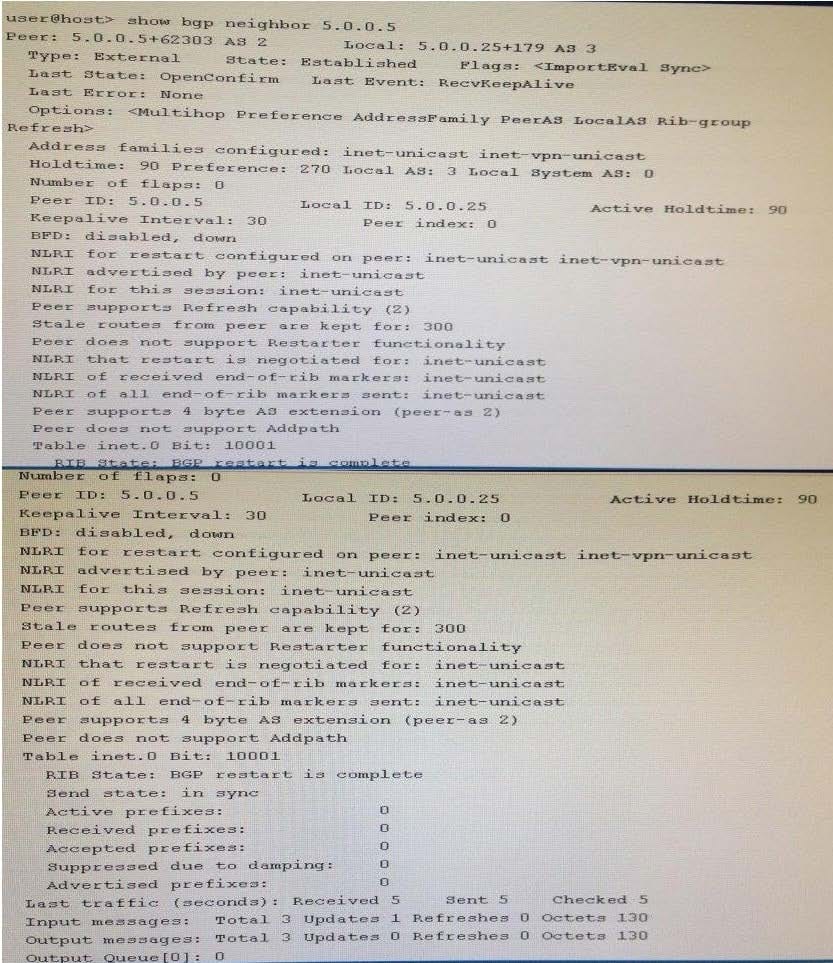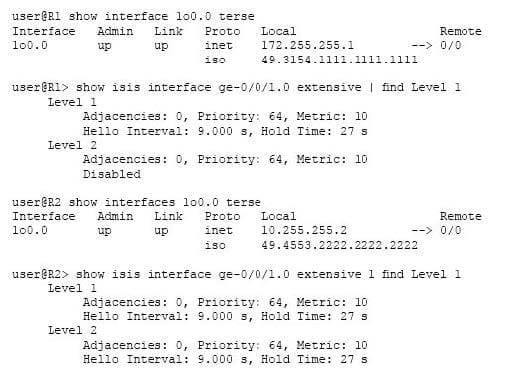Exam Details
Exam Code
:JN0-361Exam Name
:Service Provider Routing and Switching, Specialist (JNCIS-SP)Certification
:Juniper CertificationsVendor
:JuniperTotal Questions
:542 Q&AsLast Updated
:Apr 15, 2025
Juniper Juniper Certifications JN0-361 Questions & Answers
-
Question 201:
Click the exhibit button.

In the exhibit, which configuration is correct when setting up LDP for R1?
A. set interfaces ge-0/0/0 unit 0 family mpls set protocols mpls interface ge-0/0/0.0
B. set interfaces ge-0/0/0 unit 0 family mpls set protocols mpls interface ge-0/0/0.0 set protocols ldp interface ge-0/0/0.0
C. set protocols mpls interface ge-0/0/0.0 set protocols ldp interface ge-0/0/0.0
D. set interfaces ge-0/0/0 unit 0 family mpls set protocols ldp interface ge-0/0/0.0
-
Question 202:
Which address is within the IPv6 link-local address scope?
A. f80e::52c5:8d03:e8f6:57c0
B. fc00::52c5:8d03:e8f6:57c0
C. 2001::52c5:8d03:e8f6:57c0
D. fe80:0:0:0:52c5:8d03:e8f6:57c0
-
Question 203:
Which two BGP attributes are optional? (Choose two.)
A. origin
B. MED
C. cluster list
D. AS path
-
Question 204:
Click the Exhibit button.

Which statement is true regarding the output shown in the exhibit?
A. The configuration supports IPv6 multicast routes.
B. The configuration supports IPv6 unicast routes.
C. The configuration supports IPv4 unicast routes.
D. The configuration supports IPv4 multicast routes.
-
Question 205:
Click the Exhibit button.

Which two statements are correct according to the output shown in the exhibit? (Choose two.)
A. The peering session can pass inet-vpn routes.
B. The peering session is enabled for multihop support.
C. The peering session uses an altered route preference.
D. The peering session is enabled for multipath support.
-
Question 206:
What separates areas in IS-IS?
A. links
B. DIS
C. pseudo nodes
D. routers
-
Question 207:
Click the Exhibit button.

Referring to the exhibit, R1 and R2 are unable to form an IS-IS adjacency on interface ge-0/0/1.0. The ge0/0/1.0 interface has the appropriate address families enabled.
Which two actions will resolve the problem and allow the adjacency to come up? (Choose two.)
A. Change the R2 loopback interface address to 49.3154.1111.1111.1111.00.
B. Enable Level 2 adjacencies on R1.
C. Enable Level 1 adjacencies on R1.
D. Change the R2 loopback interface address to 49.3154.2222.2222.2222.00.
-
Question 208:
Which statement is true about VSTP?
A. Adding VLANs to VSTP consumes more CPU resources.
B. It supports 4093 spanning-tree topologies.
C. It is compatible with PVST+, but not with PVST.
D. Different VLANs must use different spanning-tree topologies.
-
Question 209:
Which statement about Rapid Spanning Tree Protocol (RSTP) is correct?
A. If a device configured for RSTP receives STP BPDUs, it sends STP BPDUs.
B. If a device configured for RSTP receives STP BPDUs, it forwards them as STP BPDUs.
C. If a device configured for RSTP receives STP BPDUs, it continues to send RSTP BPDUs.
D. If a device configured for RSTP receives STP BPDUs, it sends RSTP and STP BPDUs.
-
Question 210:
Which two LSA types would an ABR generate and send into a totally stubby area? (Choose two.)
A. Type 2 LSA
B. Type 4 LSA
C. Type 5 LSA
D. Type 3 LSA
Related Exams:
JN0-102
Internet Associate, Junos(JNCIA-Junos)JN0-104
Junos, Associate (JNCIA-Junos)JN0-105
Junos, Associate (JNCIA-Junos)JN0-1101
Juniper Networks Certified Design Associate (JNCDA)JN0-130
Juniper networks Certified internet specialist.e(jncis-e)JN0-1301
Data Center Design, Specialist (JNCDS-DC)JN0-1302
Data Center Design Specialist (JNCDS-DC)JN0-1331
Security Design, Specialist (JNCDS-SEC)JN0-1332
Security Design, Specialist (JNCDS-SEC)JN0-1361
Service Provider Design Specialist (JNCDS-SP)
Tips on How to Prepare for the Exams
Nowadays, the certification exams become more and more important and required by more and more enterprises when applying for a job. But how to prepare for the exam effectively? How to prepare for the exam in a short time with less efforts? How to get a ideal result and how to find the most reliable resources? Here on Vcedump.com, you will find all the answers. Vcedump.com provide not only Juniper exam questions, answers and explanations but also complete assistance on your exam preparation and certification application. If you are confused on your JN0-361 exam preparations and Juniper certification application, do not hesitate to visit our Vcedump.com to find your solutions here.
